[Editor’s Note: Regular readers of the Mad Scientist Laboratory know that human migration into ever growing urban centers is one of the key trends we track regarding the Operational Environment. Half of the world’s population migrated to urban areas in the last 10 to 15 years and estimates project 60 percent of the planet’s population will be living in urban areas within the next decade and a half. Per LTG Theodore Martin (USA-Ret.), former DCG/CoS, TRADOC, in his Foreword to TRADOC Pamphlet 525-92-1, The Changing Character of Warfare: The Urban Operational Environment, dated April 2020:
“The U.S. Army faces numerous challenges in our current and near-term future operational environments. None will be more difficult than conducting operations in the world’s urban areas. We need only cast our eyes over recent historical events to see that those operations will span 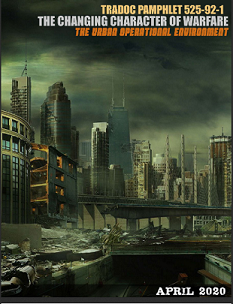 the scope of possible contingencies: large scale combat operations (Baghdad and Mosul, for example), counterinsurgency (Kabul, Kandahar, and Iraq’s cities once again), counterterrorism (9/11, London, Paris, and Mumbai), humanitarian assistance/ disaster relief (Great East Asian Earthquake and the Fukushima-Daiichi nuclear reactor failure), and others. In short, our Soldiers will confront both nature’s raw power and enemies’ use of increasingly sophisticated technologies and tactics that will at times constrain employment of our own capabilities to maximum effect. Employment of innovative concepts applicable to both competition and armed conflict contingencies such as those inherent in Multi-Domain Operations will underlie our preparations, operations, and ultimate successes.”
the scope of possible contingencies: large scale combat operations (Baghdad and Mosul, for example), counterinsurgency (Kabul, Kandahar, and Iraq’s cities once again), counterterrorism (9/11, London, Paris, and Mumbai), humanitarian assistance/ disaster relief (Great East Asian Earthquake and the Fukushima-Daiichi nuclear reactor failure), and others. In short, our Soldiers will confront both nature’s raw power and enemies’ use of increasingly sophisticated technologies and tactics that will at times constrain employment of our own capabilities to maximum effect. Employment of innovative concepts applicable to both competition and armed conflict contingencies such as those inherent in Multi-Domain Operations will underlie our preparations, operations, and ultimate successes.”
As we’ve seen with Russia in Ukraine and now with HAMAS in Gaza, the increased transparency and lethality of the contemporary battlespace is driving combatants to dig in and fortify, leveraging the dense, complex terrain of cities to provide cover and mask their activities. Subterranean operations in dense urban terrain provides defending combatants with an asymmetric advantage, offsetting conventional combined arms fire and maneuver warfighting capabilities.
With Israel Defense Forces (IDF) launching its ground combat offensive into Gaza last Saturday, 28 October 2023, Army Mad Scientist has reached back into its archives to “dust off” and feature today’s salient post from over four years ago by guest blogger Dr. Nir Buras. Dr. Buras leveraged his expertise as an urban planner to propose a holistic approach to military operations in megacities, prescribing four steps — Disrupt, Control, Stabilize, and Transfer — Read on!]
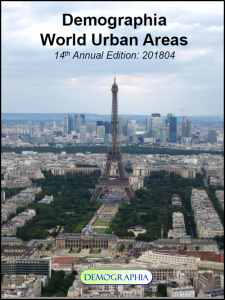 A recent study identified 34 megacities, defined as having populations of over 10 million inhabitants.1 The scale, complexity, and dense populations of megacities, and their need for security, energy, water conservation, resource distribution, waste management, disaster management, construction, and transportation make them a challenging security environment.2
A recent study identified 34 megacities, defined as having populations of over 10 million inhabitants.1 The scale, complexity, and dense populations of megacities, and their need for security, energy, water conservation, resource distribution, waste management, disaster management, construction, and transportation make them a challenging security environment.2
With urban warfare experience from Stalingrad to Gaza [again!], it is clear that a doctrinal shift must take place.
Urban terrain, the “great equalizer,” diminishes an attacker’s advantages in firepower and mobility.”3 Recent experiences in Baghdad, Mosul, and Aleppo, as well as historically in Aachen, Seoul,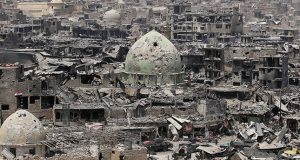 Hue, and Ramadi, shift the perspective from problem solving to critical holistic thinking skills and decision-making required in ambiguous environments.4 For an Army, rule number one is to stay out of cities. If that is not possible, the second rule of warfare is to manipulate the environment.
Hue, and Ramadi, shift the perspective from problem solving to critical holistic thinking skills and decision-making required in ambiguous environments.4 For an Army, rule number one is to stay out of cities. If that is not possible, the second rule of warfare is to manipulate the environment.
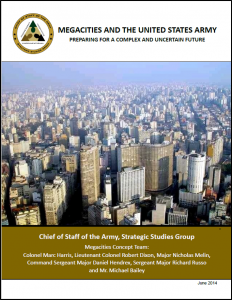 The Strategic Studies Group finds that a megacity is the most challenging environment for a land force to operate in.5 But currently, the U.S. Army is incapable of operating within the megacity.6 The intellectual center of gravity is open to those who choose to seize it, because it does not exist.7
The Strategic Studies Group finds that a megacity is the most challenging environment for a land force to operate in.5 But currently, the U.S. Army is incapable of operating within the megacity.6 The intellectual center of gravity is open to those who choose to seize it, because it does not exist.7
Cities are holistic entities, but holism is not about brown food and Birkenstocks. Holism is a discipline managing whole systems which are more than a sum of their parts. Where problem-solving methodology drags the problem with it, resulting in negative synergies (new problems); the holistic methodology works from aspiration and results in positive synergies, many of which are unforeseen. The aspiration for megacity operations is control, not conquest. The cure must not be worse than the disease.
The holistic approach to combat, to fight the urban context, not the enemy, means reconfiguring the environment for operational purposes. Its goal of reforming antagonism to U.S. interests by controlling and reforming the city to  become self-ruling and long-term sustainable, would facilitate urban, political, and economical homeostasis in alignment with U.S. interests and bequeath a homeostatic urban balance legacy — “Pax Americana.”8 Paradoxically, it may be the most cost-effective approach.
become self-ruling and long-term sustainable, would facilitate urban, political, and economical homeostasis in alignment with U.S. interests and bequeath a homeostatic urban balance legacy — “Pax Americana.”8 Paradoxically, it may be the most cost-effective approach.
Megacities are inherently unsustainable and need to be fixed, war or not. Classic planning for megacities would break them down into environmentally controllable chunks of human scaled, walkable areas of 30,000, 120,000, and 500,000 persons by means of swathes of countryside. A continuous network of rural, agricultural, and natural areas, it would be at least 1-mile deep, and be the place where transport, major infrastructure, highways, campuses, large-scale sports venues, waste dumps, and even mines, might be located.
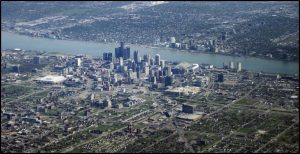 This is naturally ongoing in Detroit, is historically documented to have happened in Rome, and can be witnessed in Angkor Wat. While the greatest beneficiaries of this long-term would be the populace, its military benefits are obvious. The Army would simply accelerate the process.
This is naturally ongoing in Detroit, is historically documented to have happened in Rome, and can be witnessed in Angkor Wat. While the greatest beneficiaries of this long-term would be the populace, its military benefits are obvious. The Army would simply accelerate the process.
The idea is to radically change the fighting environment while bolstering the population and its institutions to sympathize with U.S. goals. “Divide and conquer” followed by a sustainable legacy. Notably, operations within a megacity requires an understanding of a city’s normal procedures and daily operations beforehand.9 The proposed framework for this is the long-term classic planning of cities.
The application of classic planning to megacity operations follows four steps: Disrupt, Control, Stabilize, and Transfer.
1. DISRUPT urban fabric with swathes of country at least a mile wide containing a continuous network of rural, agricultural, natural, and water areas at least 1-mile deep, where transport, major infrastructure, highways, campuses, large-scale sports venues, etc., are located. In urban fabric, structures would be removed to virgin ground, and agriculture and nature reinstated there. Solutions for the debris will need to be developed, as well as for buried infrastructure. The block layout may remain in whole or part for agricultural and forest access. Soil bacteria may be used to rapidly consume toxic and hazardous materials. This has to be thoroughly planned in advance of a conflict.
2. CONTAIN urban fabric to a 1 hour walk (2 hours max), 2-4 miles from edge to edge, both in existing fabric and in new settlements for relocated persons.
3. STABILIZE neighborhoods, quarters, and city centers hierarchically, and densify them, up to 6-8 floors tall, according to the classic planning model of standard fabric buildings. Buildings taller than 6 or 8 stories may be placed on the periphery, if they are necessary at all. Blocks, streets, plazas, and parks are laid out in appropriate dimensions. Proven, traditional designs are used for buildings at least 85% of the time. Stabilize communities through leadership, mentoring, the establishment of markets, industry, sources of income, and community institutions.
4. TRANSFER displaced communities to new urban fabric built on classic planning principles as developed after the Haiti Earthquake; and transfer air rights from land reclaimed for country to urban fabric centers (midrise densification) and peripheries (taller buildings as necessary). Transfer community management back to residents as soon as possible (1 year). Transfer loyalty; build community; develop education, mentoring, and training; and use civilian commercial work according to specifically developed management models for construction, economic, and urban management.10
To adopt a holistic approach to the megacity, the U.S. Army must engage in a comprehensive understanding of the environment prior to the arrival of forces, and plan the shaping of the environment, focusing on its physical attributes for both the benefit of the city and the Army. This holistic approach may generate outcomes similar to the type of synergies stimulated by the Marshall Plan after World War II.
If you enjoyed revisiting this post, check out the following related content:
TRADOC Pamphlet 525-92-1, The Changing Character of Warfare: The Urban Operational Environment, April 2020.
Insights from Ukraine on the Operational Environment and the Changing Character of Warfare
Learning from LSCO: Applying Lessons to Irregular Conflict, by Ian Sullivan and Kate Kilgore
Tomorrow’s Urban Battlefield podcast with Dr. Russell Glenn, and The Battle for Mosul podcast with COL Pat Work, both hosted by our colleagues at the Modern War Institute.
Current and Future Operations in Megacities Conference: Observations and Recommendations, facilitated in Tokyo on 16-19 July 2019 — also review this conference’s complete Proceedings, as well as select speakers’ slide decks, presenter biographies, and conference agenda.
Megacities: Future Challenges and Responses, documenting key insights from the Multi Domain Battle (MDB) In Megacities Conference, facilitated at Fort Hamilton, New York, on 3-4 April 2018, as well as the agenda, presenter biographies, slide decks, associated videos of presentations, and conference Proceedings.
In Urban Sickness and Health — Disasters and the Future of Megacities by Dr. Russell Glenn
War in Ukraine: The Urban Fight is Happening Now and associated podcast, and Ukraine: All Roads Lead to Urban and associated podcast, with MAJ John Spencer (USA-Ret.)
Throwback Thursday: A Chinese Perspective on Future Urban Unmanned Operations
Dense Urban Environments (DUE): Now through 2050
Dense Urban Hackathon – Virtual Innovation
2nd Dense Urban Armored Brigade (DUAB) Personnel Evaluations, by Ed dos Santos, Jr.
Fifth Generation Combat: SubTerranean Ops in Singapore, by the Radio Research Group
Military Implications of Smart Cities, by Alexander Braszko, Jr.
Integrated Sensors: The Critical Element in Future Complex Environment Warfare, by Dr. Richard Nabors
Nir Buras is a PhD architect and planner with over 34 years of in-depth experience in strategic planning, architecture, and transportation design, as well as teaching and lecturing. His planning, design and construction experience includes East Side Access at Grand Central Terminal, New York; International Terminal D, Dallas-Fort-Worth; the Washington DC Dulles Metro line; work on the US Capitol and the Senate and House Office Buildings in Washington. Projects he has worked on have been published in the New York Times, the Washington Post, local newspapers, and trade magazines. Buras, whose original degree was Architect and Town planner, learned his first lesson in urbanism while planning military bases in the Negev Desert in Israel. Engaged in numerous projects since then, Buras has watched first-hand how urban planning impacted architecture. After the last decade of applying in practice the classical method that Buras learned in post-doctoral studies, his book, *The Art of Classic Planning* (Harvard University Press, 2019), presents the urban design and planning method of Classic Planning as a path forward for homeostatic, durable urbanism.
Disclaimer: The views expressed in this blog post do not necessarily reflect those of the U.S. Department of Defense, Department of the Army, Army Futures Command (AFC), or Training and Doctrine Command (TRADOC).
1 Demographia World Urban Areas 11th Annual Edition 2015,” Demographia, 2-20, September 18, 2015, accessed December 16, 2015, http://www.demographia.com/db-worldua.pdf. 67% of large urban areas (500,000 and higher) located in Asia and Africa.
2 Jack A. Goldstone, “The New Population Bomb: The Four Megatrends That Will Change the World,” Foreign Affairs, (January/February 2010) 38-39; National Intelligence Council, Global trends 2030 Report: Alternative Worlds (Washington, DC: National Intelligence Council, 2012), 1. Quoted in Kaune.
3 ARCIC, Unified Quest Executive Report 2014 (Fort Eustis, VA: US Army Capabilities Integration Center, 2014), 1. Quoted in Kaune.
4 Harris et al., Megacities and the US Army, 22. Louis A. Dimarco, Concrete Hell Urban Warfare from Stalingrad to Iraq (Oxford, UK: Osprey Publishing, 2012) 214-215. Quoted in Kaune.
5 Harris et al., Megacities and the US Army, 21.
6 Kaune.
7 David Betz, “Peering into the Past and Future of Urban Warfare in Israel,” War on the Rocks, December 17, 2015, accessed December 17, 2015, http://warontherocks.com/2015/12/peering-into-the-past-and-future-of-urban-warfare-in-israel/. Quoted in Kaune.
8 Tom R. Przybelski, “Hybrid War: The Gap in the Range of Military Operations” (Newport, RI: Naval War College, Joint Military Operations Department), iii.
9 Kaune.
10 Michael Evans, “The Case Against Megacities,” Parameters 45, no. 1, (Spring 2015): 36. Quoted in Kaune.



